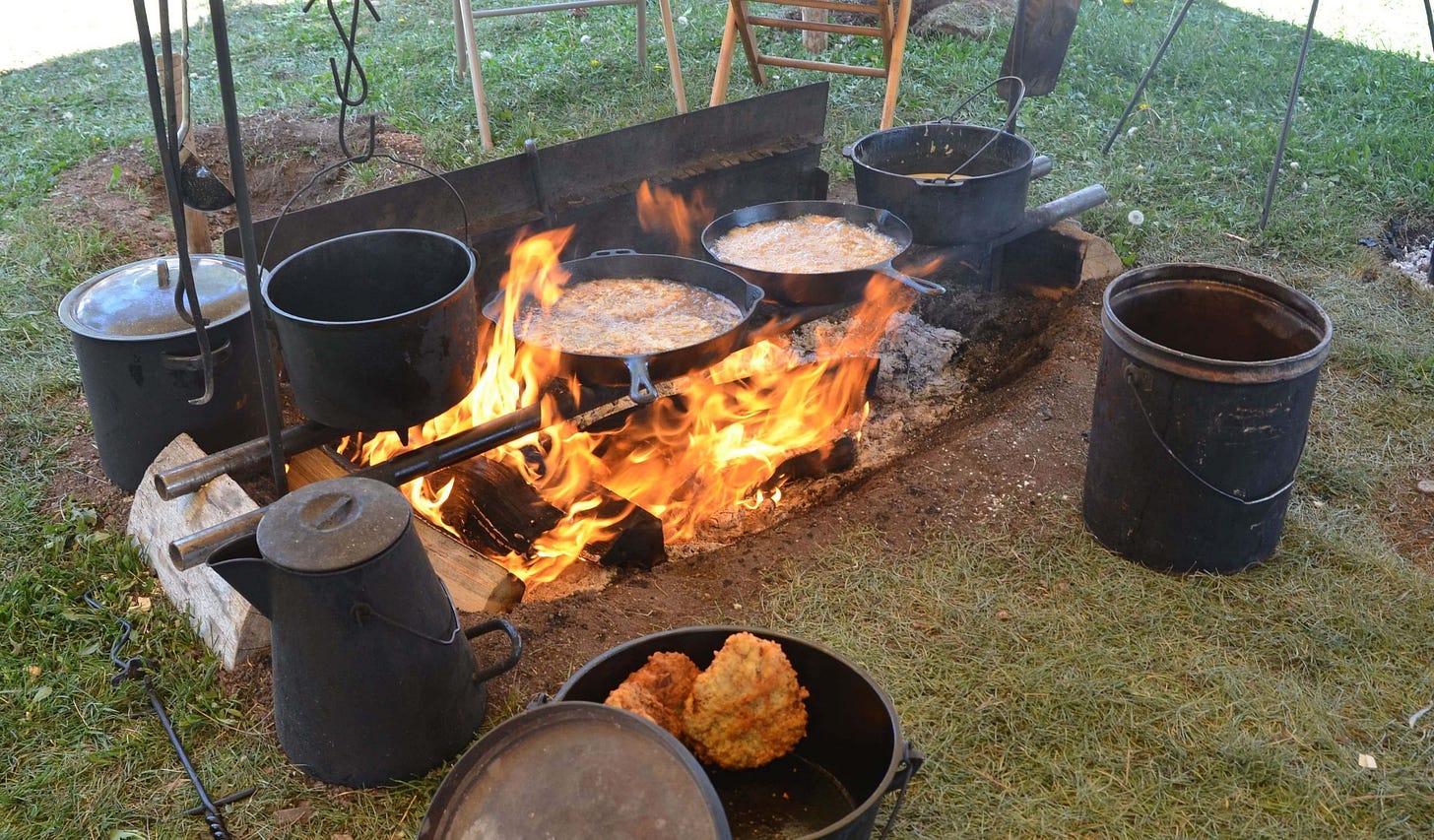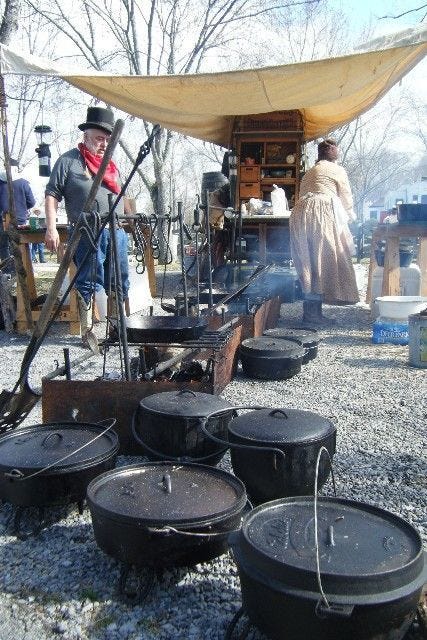Son of a Bitch!
A crowd pleaser if ever there was one.
For reasons that nobody around me understands, I’ve been fixated on son-of-a-bitch stew, aka son-of-a-gun. The only sane reason I give is to remind everyone that we’re in peak cowboy festival season.
A cowboy festival is a cross between a regular fair and a historical re-enactment. The fair is what you’d expect—fun, flashing neon lighted rides and tables of unnecessary merchandise you suddenly desperately need, all surrounded by booths selling food you never thought you’d eat but now can’t get enough of. The historical re-enactments part, though, is the real draw. You get to mill around genuine covered wagons that have been pulled into the fairgrounds by extraordinarily hefty workhorses. Parked in more or less a protective circle, the wagons are homes for the duration of the fair for people devoted to living the way many of their ancestors did when they set off for the frontier. Men dress in sturdy jeans and dusty boots, their sun-burnt faces shielded under well worn-in Stetsons. Most of the women wear long calico dresses that are a real danger around open cooking fires. Occasionally, a few women who are clearly having a lot more fun are sashaying around in the short, corseted fashions favored by saloon flossies. Children run around dressed like their parents. There are demonstrations of lassoing and steer herding. Often a blacksmith has set up shop and hammer out horse shoes. If you are very lucky, you’ll witness a rerun of a gun fight, where everyone is shooting blanks or wrestling with fake Bowie knifes. It wouldn’t be a genuine historical re-enactment if there weren’t a storyteller or two, one of whom will be dedicated to relating documented truths of the wild west and another who favors telling very tall tales about the adventurous olden days.
Honestly though, these activities pale in comparison to the opportunity for the fair goers to get their fill of authentic cowboy food offered by the participants in the cowboy festival cookout contest.
The contest rules are fairly straightforward—everything must be cooked over a fire pit and, by necessity, in an array of cast-iron pots and pans. You’ve never seen so much cast-iron in your life. There’s Dutch ovens with little feet that allow air to circulate and heat the entire vessel. You use them for baking. Then there are ovens with flat bottoms and long handles so you can hoist them onto an iron brace over the fire. This allows you to raise and lower the oven when needed to prepare beans and stews. Then there are stacks of skillets in varying sizes for frying up potatoes and eggs, and quickly searing beef.
Cast-iron almost singlehandedly wrecked America food for cooking it too fast and tough—editor’s note from the Arizona Office of the Federal Writer’s Project America Eats manuscript.
The most arduous challenge is for every wagon to possess a bona fide chuck box, a sort of a pantry on wheels, fitted with drawers for keeping ingredients, shelves and hooks for cans and such, and, most importantly, a fold out table that served as a counter to prepare and serve meals. The boxes are very hard to come by, harder than wagons, because non-cowboy re-enactors snap them up in antique stores for mere decorations. Then again, one cook found hers on eBay for a reasonable price. Etsy offers a fairly accurate replica for $8,160 but installing that in your wagon would be an automatic disqualification.
Cooks on cattle drives tended to be middle-aged or older men, frequently described as curmudgeonly. Festival cooks are the exact opposite and very often women, though many partner with their husbands. That doesn’t mean you won’t find all men or all women teams. The men are more talkative; the women too involved in their work and trying not to catch fire to care to answer questions.
The menus at each site more or less reflects what a chuck wagon cook would offer the cowboys: beans, grilled slabs of salted beef or heavily floured chicken fried steaks. Potatoes and biscuits stretched out the offerings. The biscuits were of the sourdough kind because the starter lasted the longest on the trails. Fruit cobblers and pandowny were often prepared for dessert.
This video from the National Cowboy and Western Heritage Museum in Oklahoma City tells you a lot about chuck wagon cooking, with a glimpses of a cowboy festival in the background if you can get past the museum’s corny opening.
Of the four cowboy festivals I attended there was only one contestant who wasn’t cooking among the circled wagons. He set up camp nearer to the parking lot and when I found him he was busy at his chuck wagon table cutting up serving size pieces of hearts, livers, brains, sweetbreads, a very large tongue, and a tube kind of thing that he eventually revealed was something called a marrow gut.
I’ve eaten a lot of weird, some would say, disgusting stuff in my life. Some of it was in the pile the cook was working through. But I had never seen so much of it gathered on one cutting board. Presented with such a heap, I had to ask what was going on here? How good did he expect his dish to taste after all those organs simmered in his cast-iron pot heating up over the red hot flames?
He said it was his prized son-of-a-bitch stew. I hadn’t heard of it at the time and he said he wasn’t surprise—it’s not a particularly crowd pleasing dish at cowboy festivals. If a contestant does make it, it has more beef and beans than offal, if there is any at all. This was a travesty to him because son-of-a-bitch stew formed the backbone of a chuck wagon cook’s culinary repertoire. As long as there were steers around, fresh ingredients for the stew were easy to come by. In the absence of fresh vegetables and fruit on the trail, the stew was packed with vitamins that the cowboys needed to stay strong.
“Did they like it, though?” I asked.
“Yes they did. You can look it up, too,” he said and got back to cooking his stew.
The actual cooking of the stew is an art best left to an expert such as John Raven. I would have reached out to him but unfortunately he died in 2015 at the age of 77. Luckily he left piles of ornery articles, most of them published in Texas Monthly. As all true characters are wont to do, he claimed a lot of dubious accomplishments for himself. But he did win a lot of awards and accolades for his barbecue and chili scholarship and cooking skills.
John Raven explains son-of-a-bitch stew. . . .
. . . . the stew consisted of all parts of a young calf except the hide, horns and hooves. The standard ingredients for the stew were just from the calf. The heart, liver, brains, sweetbreads, tongue, marrow gut and pieces of tenderloin made up the stew. The marrow gut is a tube that connects the two stomachs of a calf that has not been weaned. It contains a substance resembling marrow. The marrow gut is what gives the SOB stew its principal flavor. The liver was used sparingly as too much would make the stew bitter.
The marrow gut is what gives the SOB stew its principal flavor.
SOB stew was made by putting small pieces of fatty meat in the Dutch oven and rendering the fat out of it. Next went in the heart, as it is a tough cut of meat. (All the parts were cut into small pieces.) The tongue, which had been skinned, went in next. The rest of the ingredients were added in small amounts so they could cook as they went in. (You just didn't just dump everything in the pot and go watch TV.) Water was added to the stew only when absolutely necessary. The juices of the meat were usually the only liquid required. The brains were the last to be added. Usually they were cooked separately with a little flour and then added to the pot as thickening.
After my discovery of a real son-of-a-bitch cook, I returned to my hotel and took a long nap. I missed the awarding of medals for the best beans, biscuits, grills, and desserts, and, most unfortunately, the grand blue ribbon to the overall best cook. Someone won for stew, too, but it wasn’t son-of-a-bitch stew. It wasn’t finished by the judging time. The fact that there were no more than five people standing around his fire eating the stew from paper bowls, each with a chunk of bread to dip into the gravy, probably was a sign it didn’t have much of a chance to win.
He handed me a bowl. I didn’t quite dig into it. I was scared. But he was waiting for me so I finally did: I’m here to tell you that son-of-a-bitch stew is, indeed, an acquired taste. Kind of on the high offal side of flavor which you would expect. But you know what? After another spoonful I liked it. Not loved it but, really, I liked it.
A Recipe for Son-of-a Bitch stew
It’s a hard and confusing business to discern an accurate and useable recipe for the stew. Old ones start off with something like “kill off a young steer.” Modern ones are basically a beef stew with not a crumb of offal in it. The following is among the few I could understand. I found it in the 1940 first edition of Treasure Pots: Recipes Compiled by Members of the Austin Woman’s Club. It comes from Miss Ethel Foster, of Sterling City, Texas, who served as House Chairman, of the Texas Federation of Women’s Club
1/2 lb meat
1 1/2 lb marrow gut
3/4 lb heart
1/2 lb liver
3/4 lb sweetbreads
1 set brains
Cut all into small pieces (about 1/2 inch). Place all except brains in a rather large container with plenty of water. Stew slowly for 4 or hours. Add brains about an hour before done. When done add seasoning of salt and black pepper to taste. A dash of red pepper. Thicken the gravy slightly.




You sure about the brains?
Where I usually shop I have noticed over the years that fewer and fewer cuts of meat are available. Now mostly just muscle meats. But there is a lot of nutrition in the other parts.. I was once told that liver is "nutritional gold" according to someone at the Price-Pottenger Nutrition Foundation. www.price-pottenger.org
According to one story "son of a gun" refers to when sailing ships would pull into port. Ladies of the night would come on board and lay under the ship's cannons....
I enjoyed your wonderful story and wish I was there to try the stew!